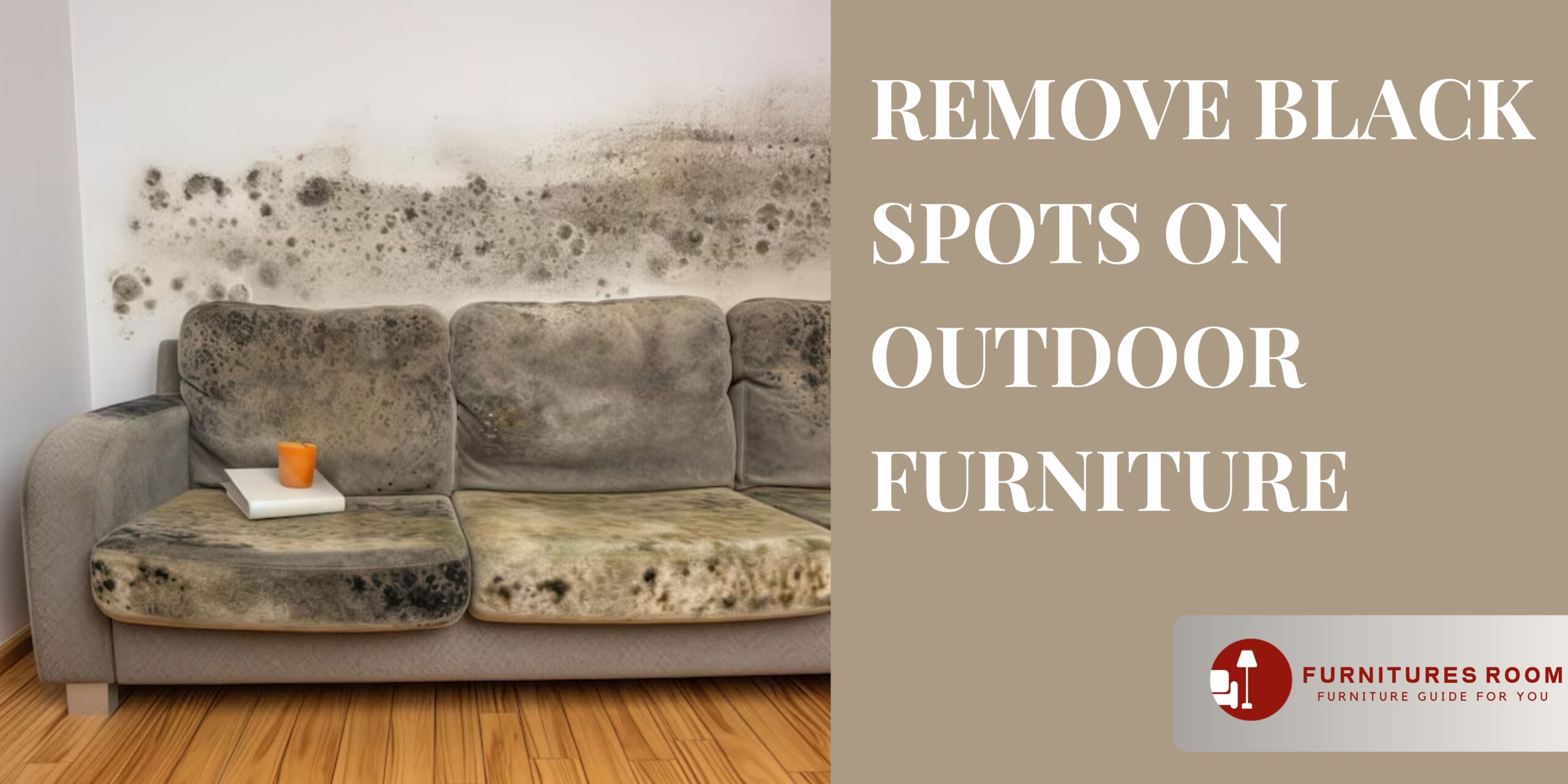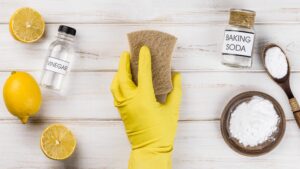
Introduction
Black spots on outdoor furniture are often caused by mold, mildew, or water damage.
To remove them, apply a vinegar or baking soda solution, scrub with a brush, and rinse thoroughly.
This guide walks you through multiple safe, easy methods based on your furniture type.
What Causes Black Spots on Outdoor Furniture?
Black spots on outdoor furniture can be caused by various factors. Let’s take a closer look at each one:
Mold and Mildew:
If your furniture is located in a damp or humid environment, mold and mildew can develop.
These fungal growths thrive in moist conditions and can leave behind greenish spots or black molds on furniture.
Oxidation:
Certain metals, such as iron or aluminium, can oxidize when exposed to air and moisture. This oxidation can create black spots or patches on the surface of your furniture.
Tannin Stains:
If your outdoor furniture is made of wood, leaves or other organic matter can release tannins, which can cause black dots. These stains are particularly common on wooden surfaces.
Identifying the cause of the black mold on outdoor furniture will help you choose the most effective method to remove them.
Step-by-Step Cleaning Methods to Remove Black Spots
Whether it’s mold, mildew, or stubborn stains, these effective cleaning methods will restore your outdoor furniture.
Soap and Water Cleaning

Start by giving your outdoor furniture a thorough cleaning using mild dish soap and warm water.
Fill a bucket with water and add a few drops of dish soap, then use a sponge or soft brush to scrub the affected areas gently. Make sure to cover them thoroughly.
Rinse off the soap with clean water and allow the furniture to dry completely before moving on to the next step.
Vinegar Solution

If soap and water didn’t do the trick, try using a vinegar solution. Vinegar is a natural cleaner with excellent antimicrobial properties.
Mix equal parts of white vinegar and water in a spray bottle. Spray the solution onto the black spots and let it sit for about 15 minutes.
Then, scrub the spots with a sponge or brush, and rinse with clean water. Vinegar can effectively remove black spots, black mold and mildew stains, leaving your outdoor furniture looking fresh and clean.
Bleach Solution

For tougher stains, a bleach solution can be used. However, it’s essential to exercise caution and follow safety guidelines when working with bleach.
Before using bleach, make sure your furniture is suitable for it. Some materials, like fabric or certain types of wood, may be sensitive to bleach and can be damaged.
Mix one part bleach with three parts water and apply it to the black spots using a sponge or cloth.
Let it sit for a few minutes, then scrub gently and rinse thoroughly with water.
Be sure to test the bleach solution on a small area of the furniture first to ensure it doesn’t cause discoloration.
Baking Soda Paste

Baking soda is a versatile and safe cleaning agent that can be used to remove black dots on outdoor furniture.
Create a paste by mixing baking soda with a small amount of water until it forms a thick consistency.
Apply the paste to the black spots and let it sit for 15-20 minutes. Scrub the spots gently with a sponge or brush, then rinse off the paste with water.
Baking soda’s mild abrasive nature helps lift stains and eliminate odors, leaving your furniture looking revitalized.
How to clean mold off outdoor furniture? Material-Specific Cleaning Solutions
Different materials require different care. Here’s how to safely and effectively remove black spots based on your furniture type:
Wooden Outdoor Furniture
Best for: Teak, acacia, eucalyptus, or painted wood
Solution: White vinegar + mild dish soap
Steps:
-
Mix 1 cup of white vinegar with a few drops of dish soap in a bucket of warm water.
-
Dip a soft-bristled brush into the solution.
-
Gently scrub the affected areas in the direction of the wood grain.
-
Let the solution sit for 10–15 minutes.
-
Rinse thoroughly with clean water and dry with a soft cloth.
Plastic and Resin Wicker Furniture
Best for: Polypropylene, resin wicker, molded plastic chairs/tables
Solution: Diluted bleach solution (10:1 ratio)
Steps:
-
Mix 1 part bleach with 10 parts water in a spray bottle.
-
Spray the black spots directly.
-
Scrub using a sponge or soft brush.
-
Rinse well to remove all bleach residue.
-
Allow to air dry in sunlight (helps kill remaining mold spores).
Metal & Aluminum Furniture
Best for: Cast iron, wrought iron, powder-coated aluminum
Solution: Baking soda paste
Steps:
-
Mix baking soda with water to form a thick paste.
-
Apply it to the blackened areas with a cloth or soft brush.
-
Let it sit for 5–10 minutes.
-
Gently scrub, especially around joints or grooves.
-
Rinse and dry immediately to prevent rust.
Prevention is Key
To keep your outdoor furniture looking great, prevention is crucial. Here are some tips to help you prevent the formation of black spots on outdoor furniture:
Regular Cleaning:
Establish a routine for cleaning your outdoor furniture.
After rainy or humid periods, make sure to give your furniture a thorough cleaning to remove any moisture or debris that may contribute to the growth of mold, mildew, or stains.
Weather Protection:
Consider using furniture covers to shield your outdoor furniture from the elements when not in use.
Covers can help prevent moisture buildup and reduce the chances of mold or mildew growth.
Proper Drainage:
Ensure that your outdoor furniture has adequate drainage to prevent water from pooling and causing prolonged moisture exposure.
Check that water can freely flow off the surfaces and away from the furniture.
Regular Inspection:
Regularly inspect your outdoor furniture for any signs of damage and black spots, such as cracks or loose joints.
Promptly repair or replace any damaged parts to prevent water infiltration, which can lead to the formation of black spots.
Leaf and Debris Removal:
Leaves, twigs, and other organic matter can release tannins, which may cause black stains on wooden furniture.
Remove any fallen leaves or debris from your furniture regularly to minimize the risk of staining.
Proper Storage:
If possible, store your outdoor furniture indoors during extreme weather conditions, such as heavy rain or winter. This will provide extra protection and prolong the lifespan of your furniture.
Frequently Asked Questions

Q1: What causes black spots on outdoor furniture?
A: Most black spots are caused by mold, mildew, or built-up dirt in moist environments.
Q2: Will vinegar damage my furniture?
A: Vinegar is safe for most surfaces but should be diluted and tested on a small area first.
Q3: Can I use bleach on plastic furniture?
A: Yes, diluted bleach can be used on white plastic, but avoid prolonged exposure to prevent discoloration.
Conclusion

Removing black spots on outdoor furniture is a manageable task with the right approach.
By understanding the causes of these spots and using appropriate cleaning methods such as soap and water, vinegar solution, bleach solution, or baking soda paste, you can restore your outdoor furniture to its former glory.
Remember, prevention is key to maintaining the beauty of your furniture, so be proactive in cleaning, protecting, and inspecting it regularly.
With a little care and attention, your outdoor furniture will continue to shine and provide you with a comfortable and inviting outdoor space for years to come.
For more detailed tips on deep cleaning specific materials like mesh, check out our Ultimate Guide on Cleaning Mesh Patio Chairs.
